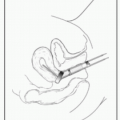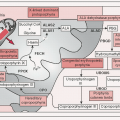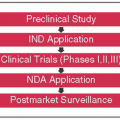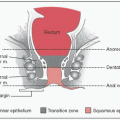MDS consists of a group of acquired, clonal disorders of hematopoietic stem cells
Ineffective hematopoiesis → cytopenias & dysplastic changes in BM precursors & circulating blood cells
Several cytogenetic abnormalities are characteristic of MDS → +8, loss or deletions of chromosomes 5 or 7, del (20q)
Recurrent Mt in genes involved in RNA splicing machinery recently identified & implicated in subset of MDS cases (eg, SF3B1 Mt a/w RS)
Non-specific sx such as fatigue, infxn, & bleeding d/t anemia (85%), neutropenia (50%), thrombocytopenia (25%)
Infxn common, resulting from neutropenia as well as impaired granulocyte function
Progressive cytopenias (though time course can vary greatly depending on subtype)
Risk of transformation to AML
DDx: AML, MPN (can be overlap), aplastic anemia, PNH, viral infxn (HIV, hepatitis, parvovirus), nutritional deficiencies (B12, copper), EtOH, meds, lead or arsenic poisoning
Most pts anemic, often w/macrocytosis (1/3 pts), & have ≥1 other cytopenia
Peripheral smear: Oval macrocytes, hyposegmented neutrophils (pseudo-Pelger-Huët cells), hypogranulated neutrophils & plt
BM: Typically hypercellular; ≥10% dysplasia in ≥1 myeloid lineage (neutrophils, RBC precursors, or megakaryocytes); impaired myeloid maturation; small &/or hypolobated megakaryocytes
BM exam also used to quantify the blast percentage & detect presence of RS (esp relevant if RA only)
| ||||||||||||||||||||||||||
Characterized by progressive anemia, preserved/elevated plt count, & del(5q) as sole cytogenetic abnormality
In addition to dyserythropoiesis, micromegakaryocytes present in most cases (80%)
Excellent RR to lenalidomide, w/most pts achieving red cell transfusion-independence & some w/complete cytogenetic response (Blood 2011;118:3765)
Rare, can be difficult to distinguish from aplastic anemia (cytogenetics helpful) although tx is similar
Now classified separately from MDS
Pts have coexisting features of dysplasia & proliferation; blast count <20%; absence of specific genetic abnormalities such as BCR-ABL, JAK-2, PDGFRα/β
CMML: Characterized by peripheral monocytosis (>1000/µL), anemia & thrombocytopenia, dysplastic neutrophils, often massive splenomegaly
IPSS score most commonly used & best validated prognostic scoring system
International Prognostic Scoring System (IPSS) Score
0
0.5
1
1.5
2
BM blasts (%)
<5
5-10
—
11-20
21-30a
Karyotypeb
Good
Int
Poor
—
—
Cytopenias
0 or 1
2 or 3
—
—
—
a Now considered AML per 2008 WHO classification.
b Good = nl, -Y alone, del(5q) alone, del(20q) alone; Poor = complex karyotype (≥3 abnls) or chromosome 7 abnls; Intermediate = any other cytogenetic abnls.
Risk Group
Total Score
Median Survival
Low
0
5.7 y
Int-1
0.5-1
3.5 y
Int-2
1.5-2
1.2 y
High
≥2.5
0.4 y
Revised IPSS (IPSS-R) score: Assigns greater prognostic significance to cytogenetics & utilizes 5 rather than 3 prognostic subgroups; uses modified cytopenia thresholds; subdivides original <5% blast count to ≤2% or 3-4% blasts (Blood 2012;120:2454)
IPSS Low/Int-1 risk: Supportive care including ESAs (epoetin alfa or darbepoetin; esp if Epo level <500); consider ESA + G-CSF for RARS; lenalidomide (esp for 5q-syndrome); if progression → hypomethylating agents (azacitidine or decitabine)
IPSS Int-2/High risk: Hypomethylating agents → survival benefit compared to best supportive care (BSC) & some pts achieve CR (9-17%) (Lancet Oncol 2009;10:223; Cancer 2006;106:1794); consider induction chemo (AML regimen such as “7 + 3”)
Allogeneic transplant is only curative strategy, usu w/a matched related or unrelated donor
Incidence: Estimated 13800 new cases in the United States in 2012 (10200 death)
Most common myeloid malignancy in adults
Median age of onset: ˜70 y
Heterogeneous clonal disorder of hematopoietic stem cells (“blasts”)
Many genotypic variants (many w/prognostic relevance)
Most pts are pancytopenic w/circulating blasts at dx → ˜50% have ↓ or nl WBC; ˜20% have WBC >100000/µL
Leukostasis can occur if WBC >50000/µL → vascular occlusion/hemorrhage (esp. of microcirculation) → visual disturbance/retinopathy, dyspnea/pulm infiltrates, myocardial ischemia, TIA/CVA → Rx w/hydration, hydroxyurea, leukapheresis
DIC: Very common in APL & frequent cause of early death (cerebral hemorrhage) → early admin. of ATRA critical at first suspicion of APL (ie, in the ER)
Tumor lysis syndrome (TLS) (more common w/ALL but can occur in AML): Ppx w/IVF & allopurinol, Rx includes forced diuresis, rasburicase, HD if sev.
BM aspirate & bx w/flow cytometry, cytogenetics, & molecular studies (KIT, FLT3, NPM1, CEBPA are standard)
R/o ALL → morphology (Auer rods are pathognomonic for AML; N:C ratio often higher in ALL); immunophenotyping by IHC/flow; cytogenetics/molecular genetic studies
Common myeloid Ag: CD13, CD33, CD34, CD117, MPO
| ||||||||||||
Age >60 y is an independent poor-risk feature
Most pts have an intermediate or unfavorable risk at presentation
|
Favorable karyotypic abnls are considered favorable regardless of other cytogenetic abnls
c-KIT Mt portends less favorable prognosis in pts w/t(8;21) [but probably not in pts w/inv(16)/t(16;16)]
Some data that NPM1 & IDH co-Mt may be very favorable, & that FLT3-ITD confers an esp poor prognosis in presence of other, newly discovered “poor-risk” Mt (eg, TET2, ASXL1, & DNMT3A) (NEJM 2012;366:1079)
A monosomal karyotype (≥2 monosomies or 1 w/other structural abnl) carries an extremely poor prognosis
Induction chemo (“7 + 3”): 7 d of infusional cytarabine & 3 d of dauno or idarubicin; RCTs confirmed high-dose dauno (90 mg/m2) superior (OS benefit) to standard dose (45 mg/m2) (NEJM 2009;361:1235); can use dauno 60 mg/m2 in older pts w/good PS
Confirm CR (<5% blasts) w/BM bx upon peripheral count recovery; persistent cytopenias >28 d after chemo → likely residual leukemia
Postremission (consolidation) Rx: High-dose cytarabine (HiDAC) → optimal dose under debate → in younger pts current standard is 3 g/m2 × 6 doses for 3-4 cycles (cerebellar tox rare but potential SE; modify dose in older pts)
No proven benefit to multiple courses of HiDAC, esp. in older pts & non-CBF leukemias
Allogeneic HCT in appropriate pts (unfavorable prognosis, strongly consider if intermediate-risk) w/suitable donor (RIC for pts >50-60 y)
Autologous HCT rarely used, though may benefit pts w/favorable or intermediate risk who received high-dose dauno (Blood 2011;117:5306)
No proven role for maintenance chemotherapy in AML (despite numerous studies)
If relapse → salvage chemo (eg, MEC → mitoxantrone, etoposide, cytarabine) vs. clinical trial → goal to achieve CR2 & consolidate w/alloHCT
MUD & matched sibling donor (MRD) HCT now have similar outcomes; UCB has expanded donor pool (Blood 2010;116:4693)
Hypomethylating agents (5-aza, decitabine) have benefit in older pts not candidates for intensive chemo (J Clin Oncol 2010;28:562)
Characterized by atypical promyelocytes (w/c are blast “equivalents”)
Driven/defined by translocation of RAR gene [t(15;17)] → aberrant fusion protein PML-RARα → blocks nl myeloid differentiation at promyelocyte stage
High early mortality rate from characteristic DIC → start ATRA early & aggressively correct coagulopathy w/FFP & cryoprecipitate
Standard Rx: Induction w/ATRA & idarubicin (or dauno + cytarabine) → consolidation w/ATRA & ATO → maintenance w/ATRA, 6-MP, oral MTX; autoHCT if relapse
Stay updated, free articles. Join our Telegram channel

Full access? Get Clinical Tree








